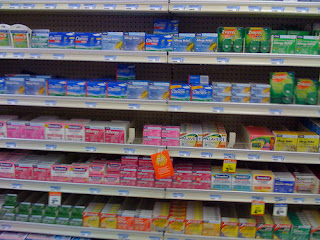Treatment
How do these medications work?
As stated before, the most common medications used for hay fever are antihistamines, mast cell stabilizers, intranasal corticosteroids, leukotriene receptor antagonists LTRAs and decongestants.
Antihistamines: There are two type of antihistamines which are classified in first generation (sedating) and second generation (non sedating). Common first generation antihistamines are azataine (Optimine), brompheniramine (Dimetane) and diphenhydramine (Benadryl). Common second generation antihistamines are loratadine (Claritin), centirizine (Zyrtec), dexofenadine (Allegra), and desloratadine (Clarinex). Both generations work by binding with the Hò receptors on target cells thus blocking the binding of histamine. Second generation agents have a decreased attraction for the receptors in the brain, which makes them preferable with the less sedating side effects. http://www.claritin.com http://www.benadryl.com
Mast cell stabilizers: The most common use of this is seen as a nasal spray, or cromolyn spray known as NasalCrom. Recall in a previous entry the physiologic process about how mast cells degranulate resulting in the histamine release? Mast cell stabilizers inhibit this degranulation in the first place of these sensitized mast cells. Medications like NasalCrom have minimal side effects, besides occasional nasal irritations however it is important to start treatment regimens prophylactically. This includes 2 weeks before the allergy season or 15 minutes before exposure to a specific allergy, such as a dog. http://www.nasalcrom.com/
Intranasal Corticosteroids: The primary corticosteroids used for hay fever come in the form of nasal sprays. Some of the common medications include budesonide (Rhinocort), ciclesonide (Omnaris), and mometasone (Nasonex). These work by being a locally used corticosteroids for the nasal passageways. Corticosteroids work by inhibiting the inflammatory response- thus decreasing the symptoms that go along with hay fever. Like the mast cell stabilizers, there is just minimal nasal burning or stinging and it should be started 2 weeks before the allergy season. However, because corticosteroids work by surpressing the immune system the body is at risk for increased risk for infections, such as Candida Albicans (a fungal infection where white patches will appear in the mouth and tongue). Also it is to be used on a regular basis, not just as needed. http://www.nasonex.com/nasx/index.jsp http://www.omnaris.com/
Leukotriene Receptor Antagonists (LTRAs): The most common LTRA is montelukast (Singulair). This works by antagonizing or inhibiting leukotriene activity. Normally when leukotrienes are released, they cause a slow-reacting substance of anaphylaxis (SRS-A) leading to many of the respiratory symptoms. These include narrowing of airway and increased edema in the airway. By inhibiting these to be released, these symptoms are able to be avoided. Unlike many of the other medications listed here, there are many side effects that go along with the use of LTRAs. These include from a range of headaches, and dizziness to altered liver function tests. Therefore it is important to monitor liver function, take on an empty stomach, and not be be used for acute attacks of symptoms. Also, medications such as singular are more common for chronic respiratory conditions such as asthma. This would not be a first round choice for those with hay fever especially with just mild to moderate symptoms. http://www.singulair.com/montelukast_sodium/consumer/asthma/asthma-medication/index.jsp
Decongestants: Perhaps with the antihistamines and intranasal corticosteroids, decongestants are a very popular choice for hay fever, especially for those who have a little more severe sinus/nasal symptoms. The most common decongestant is pseudoephedrine (Sudafed). These decongestants can also be recognized for being added to other medications with the addition of a “D” to the name. Ex: Claritin D. These work by stimulating adrenergic receptors on blood vessels causing them to constrict. As a result congestion decreases from the reduced nasal edema and rhinorrhea. Because it acts on the adrenergic receptors some side effects are from the cardiovascular system such as increased blood pressure, increased heartbeat and excitation/irritability. Another important thing to keep in mind with decongestants is that you have to buy them from the pharmacy counter and purchases marked through your driver’s license. Why? The key ingredient in these decongestants (ephedrine or pseudoephedrine) is used in the production of meth. http://www.sudafed.com/
If you have any questions about what medications you should be taking or about any of the side effects make sure to talk to your doctor and pharmacist. Also check out www.rateadrug.com to evaluate your treatments. Also use it to read about other people’s questions or input on medications you may be taking or thinking about taking.

No comments:
Post a Comment